| |

Traditions, folklore, history and more. If it's Irish, it's here. Or will be!
"People will not look forward to posterity who never look backward to their ancestors."
-Edmund Burke




Quotes
Library: Books, Movies, Music
Prints & Photos
Poetry
Jokes


Shops Ireland
Bunús na Gaeilge
(Basic Irish)
Circle of Prayer
Blessings
Did You Know?
Himself/Herself
Write to Us
Readers Write..
Links/Link to Us
Advertise with us
Awards & Testimonials
Submissions Guide

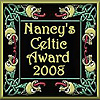
|
|
|
Counties of Ireland - Carlow
by Bridget Hagg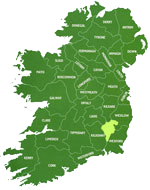 erty erty

Ballybitt, Rathvilly, Co. Carlow, Eire. That's all you'd need to put on the envelope if you were writing to several of my cousins in Ireland. Even when I was a little girl, I was fascinated by that address. We still haven't made it to this area of the Emerald Isle, but after doing just a wee bit of research, it's definitely on our itinerary for a future visit. Besides, it's only fair - the last time we were there, the cousins came to meet us at the Burlington House hotel in Dublin - about fifty miles away. Next time, we're meeting them on their own turf!
Located in the south east of Ireland, the modern name Carlow comes from the Irish word Ceatharlach which means "four lakes" and is probably derived from the overflowing of the rivers Barrow and Burrin.
With an area of 346 square miles, Carlow is the second smallest Irish county and one of only twelve that is land-locked; it is bordered by the scenic Blackstairs Mountains to the east and the fertile limestone land of the Barrow Valley and the Killeshin Hills to the west.
Before the Norman invasion in the twelfth century, Carlow formed the northernmost part of the Gaelic kingdom of Uí Cinnseallaigh, which also took in parts of the neighboring counties of Wicklow and Wexford. The county was part of the lands of Dermot MacMurrough, the Leinster king who formed the first alliance with the Normans and facilitated their invasion in the twelfth century.
The first castle in Co. Carlow was built by the invading Normans and by the middle of the 14th century over 150 castles had been built. While none survive intact, some imposing ruins remain as a reminder of eight centuries of history. Carlow's strategic position ensured it a significant role in the turbulent history of Ireland. During the 1798 Rising, over six hundred nationalist rebels were massacred here. Over four hundred of them - "The Croppie Boys" memorialized in the famous song - are buried near Graiguecullen at the stone quarries. Besides Carlow Castle, others worth visiting include The Black Castle, Ballymoon and Clonmore Castle.
Known as the "Celtic Center of Ireland," because of its numerous historic and ancient sites, the county’s most prominent feature is the granite formation known as Browne Hill's Dolmen, a portal tomb which is over 5,000 years old. Its capstone weighing over 100 tons is reputed to be the largest in Europe.
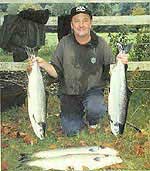 In addition to being steeped in history, Carlow is just as picturesque as other Irish counties. Besides its dramatic mountain vistas, it has two major rivers - the Barrow and the Slaney - which are renowned for some of the most delightful stretches of water in Ireland. They wind a twisting course southward through the county and are ideal for salmon, trout, coarse fishing and river cruising. In addition to being steeped in history, Carlow is just as picturesque as other Irish counties. Besides its dramatic mountain vistas, it has two major rivers - the Barrow and the Slaney - which are renowned for some of the most delightful stretches of water in Ireland. They wind a twisting course southward through the county and are ideal for salmon, trout, coarse fishing and river cruising.
There's also no shortage of other things to do - from exploring historic castles, ancient tombs, and lush gardens to hill-walking, golfing, and horseback riding. The county has much to offer and it makes an excellent base for touring the "Sunny Southeast".
Towns, Villages & Points of Interest
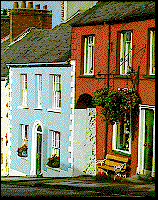 Carlow Town & Carlow Castle Carlow Town & Carlow Castle
Tradition has it that the Norman town of Carlow was built on a site separated from the Castle by a swamp, which was formed by the two town rivers. This swamp was situated near Kennedy Street and was referred to as the 'Moneen' (marshy area).
Dean Swift once described Carlow town, with this rhyme:
High Church
Low Steeple
Poor Town
Proud People.
The renowned playwright George Bernard Shaw had strong Carlow connections through his mother’s family, the Gurlys, who went back to the seventeen hundreds. Shaw bequeathed several properties to Carlow town, the first of which was then the Assembly Rooms, in Dublin Street, which became Carlow Technical School and is presently the County Library.
The town's thriving industries include a beet sugar factory, flour milling and malting. Carlow has long had the feel of a university town. St Patrick's College - the first ecclesiastical college in Ireland - has been joined in recent years by the Regional Technical College, adding to third level academic activities and the student population.
One of the most impressive pieces of architecture in the town has a very interesting background; it is believed that the courthouse on Dublin Street, modeled on the Parthenon in Athens, was originally meant for Cork, but the plans for the two buildings became mixed up.
A wide range of accommodation options awaits the visitor and Carlow Town is the ideal base from which to explore the county. After dark, a wide range of entertainment options are available, including traditional music in the pubs and frequent shows at the famous Little Theater during the tourist season.
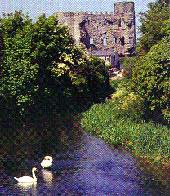 Carlow Castle constructed between 1207 and 1213 is thought to have been built by William the Marshal, Earl of Pembroke and Lord of Leinster to guard a vital river crossing. The earliest charter on record relating to Carlow was also granted during this period, around 1209. The Castle has a long and chequered history as Carlow was at one time an important and strong military fortress strategically sited at the confluence of two rivers, on the south eastern corner of the Pale. Carlow Castle constructed between 1207 and 1213 is thought to have been built by William the Marshal, Earl of Pembroke and Lord of Leinster to guard a vital river crossing. The earliest charter on record relating to Carlow was also granted during this period, around 1209. The Castle has a long and chequered history as Carlow was at one time an important and strong military fortress strategically sited at the confluence of two rivers, on the south eastern corner of the Pale.
The original keep was 3 storeys high and was square with stout three-quarters round towers at the corners, but only the eastern half still stands, with its two corner towers and the connecting wall. The entrance was through a door in the first floor of the north side. The topmost storey of the north-western tower is of 15th-16th century date. Although the castle is only first mentioned in 1231, it was probably built by William the Marshall or by his son not long after he gave a charter to the town in 1208. William's grandnephew handed it over to the Crown on his death in 1306. In 1312 it was granted to Thomas Plantagenet, surnamed 'de Brotherton', who became Earl of Norfolk, and it remained in possession of the same family until it was confiscated by the Crown in 1537 because the owners were absentee landlords. It was already in bad repair by 1307. It was captured in 1535 by Silken Thomas, but was retaken after a short siege. It was bought by Donough, Earl of Thomond, in 1616.
During the 1640s it changed hands many times before being taken by Cromwell in 1650, but it was later returned to the Earl of Thomond. Having later passed into the hands of the Hamilton family, it was granted to a Dr Middleton who, in order to create more room for the building of a lunatic asylum in 1814, blew up parts of the castle! As a result, most of the castle had to be demolished as a safety precaution, leaving only the two towers and adjoining wall of what was once one of the finest Norman castles in Leinster.
Carlow Museum
Located in Carlow Town Hall, the Carlow Museum is operated by the Old Carlow Society. It displays, in a series of shop layouts, aspects of early nineteenth and twentieth century domestic and commercial life in the Carlow area. It also houses a fine display of Celtic artifacts found locally.
Carlow Mini Brewery
Located at Station Road, Carlow, and opened in August 1998, this Mini Brewery currently provides just two varieties of beer brewed on site and served in a 'themed' transport bar. Located in a former railway store, the brewery retains a lot of the feel and flavour of this fine stone building. The aim of Carlow Brewing Company is to produce high quality beers for the local Carlow area reminiscent of those once brewed in this region as far back as the Celtic times.
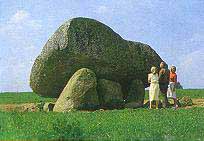 Browne Hill's Dolmen Browne Hill's Dolmen
Located at Rathvilly Road, Carlow, a field monument of huge proportions, the capstone is believed to be the largest in Europe. The location, setting, and purpose of this megalithic structure have been the subject of conjecture for centuries. Most likely, it marks the burial place of a local king from long ago but has been invested with a rich overlay of myth and legend. Access is direct via the carpark and enclosed pedestrian pathway.
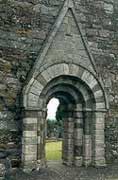 Killeshin Romanesque Doorway Killeshin Romanesque Doorway
Killeshin derives its name from one of the abbots of its famous monastery - Uisin, Gleann Uisin meaning the Glen of Uisin. Killeshin is a small rural community of approximately 1300 people. It is situated 5km west of Carlow town and overlooks the picturesque Barrow Valley. The Church at the foot of the Killeshin Hills is the site of an early Christian monastery.
The Church, a preserved ruin, is on the site of an old monastery founded by Saint Comghan towards the end of the fifth century. The present church features a very fine romanesque doorway which is now a national monument. The well preserved doorway features stone carvings of heads with intertwining hair, foliage and animal motifs. A very rare example of Irish Romanesque architecture.
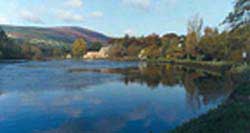 St. Mullins St. Mullins
This is the site of the famous monastery founded by St. Molling, a place of great learning and holiness. The saint is reputed to have promised that those buried in the graveyard would go straight to Heaven. There is a Pattern held there every year. Here, the river is tidal and at the time of trading, the boats were met by a steamer which took them out on the early morning tide.
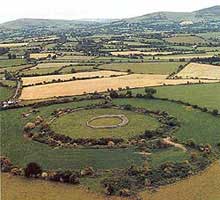 Rathvilly Rathvilly
The tiny village of Rathvilly, where my cousins still live, became a by-word amongst Ireland's Tidy Towns and Villages winners when it won the All Ireland title for Ireland's tidiest town on three occasions. In the centre of the village is a monument to Kevin Barry, a local boy who joined the fight for Irish freedom. Today, his name is also immortalized in one of Ireland's best-beloved ballads. On the outskirts of the village is reinforced earthworks which date from ancient times. The village has a commanding view of the surounding countryside with the mountain ranges of Lugnaquilla, the Blackstairs and the Slieve Blooms in clear view.
Tullow
Tullow, the main town in the east of the country, is a center for anglers fishing the Slaney and other nearby rivers. In the market square stands a statue of Father John Murphy, the insurgent leader, who was captured near Tullow and executed here on 2 July 1798. The town is conveniently placed for exploring the beauty spots of south Wicklow and north Wexford, as well as those of Carlow itself.
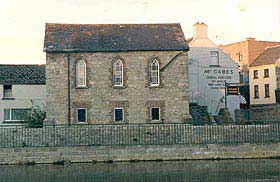
Muine Bheag/Bagenalstown
Three miles south of Leighlinbridge, on the River Barrow, is the pleasant town of Muine Bheag, also known as Bagenalstown, a fishing and hunting center. Eight miles downriver from Muine Bheag is the little town of Borris. It offers great golf and is also a good point from which to explore the Blackstairs Mountains to the east (highest point Mount Leinster 2,610 feet).
In nearby Borris is the home of the MacMurrough Kavanaghs, descendants of Diarmuid MacMurrough, King of Leinster. One of the most notable of this family was Arthur MacMurrough Kavanagh, who was born in 1831 without arms or legs. His story is a remarkable tale of victory over adversity, as he managed to lead a very full life despite his physical handicap. He managed to attend to himself in every way and traveled extensively all over the world. He married and fathered seven children, and he was MP for Carlow from 1866 to 1880. By means of a steel hook protruding from his sleeve, he could fish, hunt, sail and shoot. A very good story is told of his arrival at Abbeyleix, County Laois, by rail for a shoot at the Devesci Estate. As the station master helped him from the train to his carriage he said ‘you are welcome back to Abbeyleix, Mr Kavanagh’. Later in the day while shooting with a gun that he had adapted to strap to his shoulders, Kavanagh commented: ‘Amazing, I have not been in Abbeyleix for 15 years and the station master recognised me’. Arthur died in 1889 at the ripe old age — for that time — of 76 years.
 ballon ballon
This little village is located in the heart of the county. Its claim to fame is just a short distance away - Altamont Gardens, which are set in a small and uniquely beautiful estate.
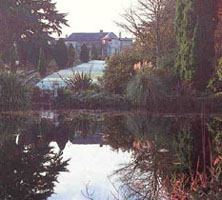 One of Carlow's premier tourist attractions. and known as the most romantic garden in Ireland, Altamont is an enchanting blend of formal and informal gardens. It ranks in the top ten of Irish gardens and is often referred to as 'the jewel in Ireland's gardening crown.' One of Carlow's premier tourist attractions. and known as the most romantic garden in Ireland, Altamont is an enchanting blend of formal and informal gardens. It ranks in the top ten of Irish gardens and is often referred to as 'the jewel in Ireland's gardening crown.'
Lawns are bisected by sculpted yews sloping down to a romantic lake surrounded by rare trees, rhododendrons and shrubs. A profusion of roses - old fashioned and modern, and herbaceous plants scent the air. A fascinating walk through the Arboretum, Bog Garden and Ice Age Glen with its canopy of ancient oaks leads to the majestic River Slaney. Along the River Walk, you may see salmon and trout rising, perhaps even an otter, and throughout the garden, an abundance of birds and butterflies. On your return via the Hill Walk, there are wonderful views of the Blackstairs and Wicklow Mountains and Mount Leinster.
Parts of Altamont date back to the 1500's when nuns were reputed to live here. A new road was made in about 1720 from Carrickslaney to Kilbride when the then owners of Altamont, the St. George family, were obliged to turn the house back to front. They made new back and front avenues with the handsome granite entrance gates and planted the beech trees to line the avenue and the old Nun's Walk. They also built the bow fronted Georgian dining room and hall porch with its decorative fan light typical of that era.
Later additions were built on in the 19th Century and the lake was dug to give employment during the Famine. The Broad Walk and terraces leading down to the lake were laid out in about 1850 and many beds and pools and pergolas added; with urns and statuary in appropriate places around the lakes. Walks were made through the ancient oak woods of the Ice Age Glen down to the River Slaney and along its bank. A flight of 100 granite stone steps (again hand-cut during the famine) lead up from the river, to where the present path winds back through the woods, which are carpeted with bluebells, ferns and wild daffodils.
Clonegal
Beautifully located on the Carlow-Wexford border is the village of Clonegal. This marks the joining of the Slaney and Derry rivers. The Wicklow Way passes close by.
Clonmore
In the northeast of Carlow the village of Clonmore is recommended for the visitor with an interest in the heritage of Ireland. This has been recognised by the establishment of a Heritage Tour encompassing the main attractions, including Clonmore Castle.
Hacketstown
Hacketstown is situated in the foothills of the Wicklow Mountains and the area has a wide variety of delightful views and walks. The town was the scene of a fierce engagement between the insurgents and the yeomen in 1798. Eagle Hill, south of the town, has delightful views from its summit and most of the county can be seen spread out below like a relief map.
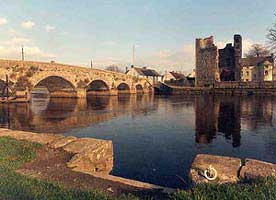 Leighlinbridge Leighlinbridge
Leighlinbridge is pleasantly situated by the River Barrow and the river is spanned here by a fine stone bridge with Black Castle on its eastern side. This was where one of the earliest Norman castles in Ireland was erected in 1181. Black Castle withstood many sieges by the MacMurrough Kavanaghs. The first Carmelite priory in Ireland was founded here in 1270 by the Norman family of Carew.
Among the warriors of the county was Myles W. Keogh, born at Orchard House, Leighlinbridge. In 1860, Myles enlisted in the Papal Army of Pius IX as a second lieutenant in the Battalion of St Patrick. After the capture of his very ill-equipped regiment, which after a brave fight was forced to surrender, Myles and his comrades were prisoners of war for a short time before being repatriated. Some of them, including Myles, decided to stay on as regulars in the Papal Army. Myles had distinguished himself at the Battle of Ancona, and had received two Papal medals.
At the outbreak of the Civil War in America, Myles joined the United States Army as a Captain. After long service in the Army of the US he was attached to the regiment of General George Custer, and became second in command. In 1876 he fought at the Battle of the Little Big Horn when Sitting Bull and Crazy House wiped out the entire regiment, leaving nothing living except the horse of General Myles Keogh, named Commache. This horse was taken care of by another Irishman, Captain Nolan. The horse was made subject to an army order, he was never ridden or worked again, but was kept as a living memorial to the battle. When Commache died 20 years later he was skinned and stuffed and is now on exhibition in the university of Kansas.
All the soldiers killed at the Battle of Custer’s last stand were mutilated and scalped, with the exception of Custer and Myles Keogh. When Sitting Bull was killed in a later battle he was found to be wearing a Papal Medal.

Another famous man born at Leighlinbridge, was the scientist, John Tyndall. Tyndall, who was born and educated in the parish of Leighlinbridge, was a recognised genius. He was the first person to discover why the sky is blue.
Myshall
A small village at the base of the northwestern slopes of the Blackstairs Mountains, there is a lovely drive from Myshall up to Mount Leinster and the nine stones lookout point. There's also a magnificent church in the village - the Adelaide Memorial Church. Built as a miniature of Salisbury Cathedral, this architectural gem was completed in 1913 by London businessman John Duguid as a memorial of love to his daughter following her death on the hunting field. Rathnageeragh Castle, near Myshall consists of a square gatehouse with two storeys.
Nurney
Pleasantly situated in central Carlow with splendid views of Killeshin Hills, Nurney is an ideal touring cener.
"Big Houses"
There were many stately homes in the county or what were known as Big Houses. To mention but a few of these families, there were the Bruens of Oakpark — an estate now owned by Teagasc, the Browns of Brownshill, Ducketts of Ducketts Grove (this is the house shown), Burtons of Burton Hall, Rochforts of Clogrennan, and Bagnels of Dunleckney, who gave their name to Bagnelstown. The proximity of Carlow to Dublin and the quality of the land was a big factor in its plantation.
While it was a great deal of fun finding out about Carlow, it also dawned on us that there might be readers who think they may have ancestors from here - or any of Ireland's beautiful counties. So, we'll end each of our explorations in this Counties of Ireland series with what we hope is some assistance in finding ancestors.
Finding ancestors in Carlow
In the Famine and the subsequent emigration, Carlow's population shrank from 86,000 in 1841 to 41,000 in 1966, a drop of 52%. Today the population stands at around 45,000.
The most common surnames: A Griffith’s valuation was carried out in Carlow in 1852. At that time the most numerous household surname in Carlow was Byrne, with no less than 498 Byrne households in the county, followed by Nolan/Nowlan with 310. The top names, according to Griffith’s valuation, were: Byrne , Nolan/Nowlan, Kavanagh, Kelly, Neill, McDonnell, McDonald, Kinsella, Whelan, Ryan, Brennan, Walsh.
Carlow Research Centre
Carlow Genealogy Project
Old School
College Street
County Carlow
Ireland
Tel/Fax: + 353 (503) 30850
Email: carlowgenealogy@iolfree.ie
Resources & Images:
Content edited and adapted from: Local Ireland
Rootsweb
Carlow Links
ebook Ireland
Carlow Brewing
Carlow Tourism
Carlow
Irish Roots Magazine published by Belgrave Publications.
|
|
Fri, Sep 27, 2024
 The Galway Hooker The Galway Hooker
This unique vessel, with its distinctive curved lines and bright red sails, originated in the village of Claddagh. During the 19th century, hookers supported a significant fishing industry and also carried goods, livestock and fuel. Seán Rainey is remembered for building the last of the original boats, the Truelight, for Martin Oliver who was to become the last king of the Claddagh; as king, he was entitled to white sails on his boat. Since the mid seventies, many of the old sailing craft which were on the verge of extinction have been lovingly restored and new ones have been built. During the summer months they can be seen at festivals such a Cruinniú na mBád - the Gathering of the Boats - in Kinvara.
Click for More Culture Corner.
A magnificent pictorial tribute to the splendor of Irish gardens, featuring more than 200 color images.
Eclare ushers readers into spectacular Irish garden settings...
Equally captivating are the book's gorgeous photographs of plants, beautiful stonework, outstanding statuary, and the voluptuous floral compositions that adorn Ireland's great castle estates, rural herb growers, country guest houses, and quaint cottages.
Alice Joyce
Click for Glorious Gardens.
|
|
|
|
|




 The Galway Hooker
The Galway Hooker